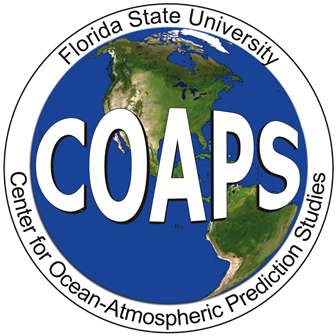There is a long tradition at the Center for Ocean-Atmospheric Prediction Studies (COAPS) of exploring the physical environment of the Gulf of Mexico using high-resolution numerical models. For example, Morey at al. [2006] recently investigated the reason why the actual height of the storm surge generated by Hurricane Dennis on the North Florida Coast was 8-10 ft. instead of the predicted 3 to 5 ft. The main reason is that, although Dennis had only modest winds off West Florida, these winds pushed water on shore which morphed into a barotropic shelf wave that propagated to St. Marks, Florida and nearly doubled the surge caused by local winds. This led to NOAA modifying storm surge forecasting methods in the Gulf of Mexico by including larger model domains to capture the correct physics associated with remotely generated sea level anomalies.
COAPS scientists are presently using two model configurations:
The first one uses the Navy Coastal Ocean Model (NCOM) developed at the U.S. Naval Research Laboratory which is a three-dimensional primitive equation ocean model that has been optimized for running on supercomputers. The NCOM simulations serve as a virtual laboratory for studying the physics of the ocean circulation within the Gulf of Mexico. Projects include studies of the Loop Current and its eddies within the deep ocean, the circulation on the continental shelves near the coast, the interaction of eddies with the waters of the continental shelves, and the effects of river discharge on the ocean environment. Additionally, the model is being used for studies to advance our understanding of numerical methods, ocean prediction systems, and air-sea interaction.
The second configuration is based the Hybrid Coordinate Ocean Model (HYCOM) which is presently being run in near real-time by the Naval Research Laboratory (NRL) at Stennis Space Center, MS. More specifically, the goal is to further develop this configuration within the framework of the Northern Gulf Institute into a coupled ocean-atmosphere-biogeochemical 1/25¡ (~ 3.5 km grid spacing) modeling system that will include a) forcing from a high resolution regional atmospheric model, b) a wave model in order to improve the flux computations, c) real-time river discharge, d) tidal forcing, and e) a complex biogeochemical model. Output from the resulting system will be distributed to the the community in order to provide boundary conditions for regional very high-resolution ocean circulation and ecosystem models and downscaled atmospheric models. A very high-resolution regional model of the northeastern Gulf is being developed at COAPS and will be nested within this Gulf of Mexico HYCOM modeling system.
Contact Steve Morey at

